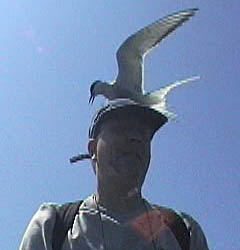This first isn't a ball fungus, but I decided to revisit one of my finds of 2006, the wood cauliflower, which is at least ball shaped. This year it is even bigger - comfortably football sized as you can see from this shot


 It may even have a bit to grow yet, although I'm not sure when I'll get back to see. Whilst at the hospital I took the chance to see if another of last years finds was there again. This shot from last year shows the ruptured stump puffballs.
It may even have a bit to grow yet, although I'm not sure when I'll get back to see. Whilst at the hospital I took the chance to see if another of last years finds was there again. This shot from last year shows the ruptured stump puffballs. This year I was obviously earlier, and the fruiting bodies were still spiny. Quite a few had ruptured, but the spores hadn't formed.
This year I was obviously earlier, and the fruiting bodies were still spiny. Quite a few had ruptured, but the spores hadn't formed.
 Out in the Forest of Dean I'd come across a couple of puffballs of a different type. I think they may be 'common', but my book doesn't show the cluster of darker spines around the exit hole on the top.
Out in the Forest of Dean I'd come across a couple of puffballs of a different type. I think they may be 'common', but my book doesn't show the cluster of darker spines around the exit hole on the top.
 But my favourite was a fungus I'd seen in the BBC wildlife magazine, yet doubted I'd find. Let alone just a couple of hundred yards up a busy road from our house. These bizarre things are earthstars. Sadly I was just a little late and they'd all released their spores, but still pleasing. I was disappointed to read that most don't return in the same place in successive years, but you never know. One for the calendar.
But my favourite was a fungus I'd seen in the BBC wildlife magazine, yet doubted I'd find. Let alone just a couple of hundred yards up a busy road from our house. These bizarre things are earthstars. Sadly I was just a little late and they'd all released their spores, but still pleasing. I was disappointed to read that most don't return in the same place in successive years, but you never know. One for the calendar.If you really want to see how to take a photo of one of these beauties click on the link to David Slater's website. http://www.djsphotography.co.uk/British%20Plants/Fungi.htm
We mere mortals can but dream!


































